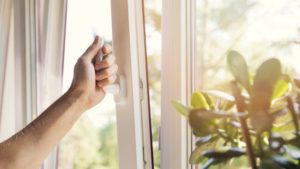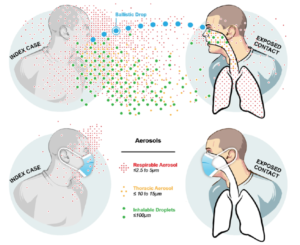December 20, 2020
By Luke Powell, WELL AP, LEED AP
Ventilation. A term that most people outside of the HVAC world rarely heard until a few months ago. As the COVID-19 pandemic escalated, and the CDC and WHO finally started to recognize airborne transmission, ventilation quickly became a buzz word.
So why does ventilation matter? The virus that causes COVID-19 is spread through very small aerosols and droplets released in exhaled breath. There is mountains of evidence to show that these aerosols can be carried more than 6 feet in the air and could cause infection if they are inhaled. This is most likely to happen in indoor environments when the ventilation in a room is poor. The longer the period of time people spend in a space, the more likely the virus is to build up in the air and be inhaled, leading to infection.
Don’t Building Codes require a “safe” amount of ventilation? Not enough to quickly remove a virus from the air! After all, buildings were not designed to have air as clean as a research lab or operation room.
ASHRAE Standard 62.1 is the governing standard in the HVAC Industry when it comes to acceptable ventilation levels in commercial buildings. There are outdoor air requirements based on building type, occupancy level and even considerations for the quality of the outdoor air that is being brought in.
ASHRAE 62.2 is the standard that defines the roles of and minimum requirements for mechanical and natural ventilation systems and the building envelope intended to provide acceptable indoor air quality in residential buildings.
The 2019 edition of Standard 62.2 adds a compliance path that gives credit for particle filtration, distinguishing between balanced and unbalanced ventilation system interactions with natural infiltration, requiring compartmentalization limits for new multifamily dwellings, and allowing for single-point envelope leakage test results to be used when calculating infiltration credit.
However, most residential buildings are not new and even new one’s likely have local building codes that are not up to the 62.2-2019 standard.
In the vast majority of homes in the United States, there is no mechanical system supplying outside air (ventilation) indoors and exhausting indoor air outside. The only way homes are typically ventilated is by opening a window and/door, or by small amounts of air leaking through openings and cracks in the building walls or roof. Homes generally recirculate ALL indoor air through AC unit/ furnace filters when the heating or cooling system is operated.
The majority of the focus during this pandemic has been on commercial buildings with low ventilation. Offices, restaurants, schools, grocery stores, retail businesses are all spaces where we have identified that the risk of infection increases drastically due to shared air in a poorly ventilated space with an infected person.
Over the next few weeks, people will be spending just as much time, if not more, in their homes than these other spaces. It is important to recognize that the ventilation in your home is likely lower than a restaurant. If you have a group of friends or family over for dinner for a couple of hours, airborne aerosol virus particles from an infected person will build up inside with no path out of the home.
So what can you do? If spending time inside a house with people you do not live with is in your plans, there are some things you can do to make it safer.
- Reduce exposure time. One hour is much better than two or three.
- Schedule events when you can do it outside, maybe on a slightly warmer day or find a way to gather with portable heaters or a fire pit.

- Increase ventilation by cracking open a few windows. The bigger the opening the better. Yes you will be wasting heat, but it should be done while people are in your home and for a few hours after they leave. Ventilation rates through openings are determined by the wind speed and temperature difference between indoors and outdoors, and in colder weather opening the window a small amount can result in ventilation that is almost as effective as opening the window fully in the summer.

- Turn on exhaust fans in your bathrooms and kitchen. This will increase infiltration of outside air into your home. However, always make sure you have a window/door open for the make-up air. It is possible if you don’t, that the make-up air will come from your combustion sources possibly contributing CO to the air quality in your home (and make sure you have a CO detector).
- Add a portable air cleaner. Run your furnace to recirculate the indoor air and get more running through the cleaner. There are a vast number of different air cleaners on the market and it can be difficult to choose one that is effective. Air cleaners that are based on filtration (with a HEPA filter) are likely to be most effective. It is important to remember that air cleaners should be used as a supplement to increased ventilation, not instead of.
- Socially distance when you are visiting a friend’s home and wear your mask while not eating. Spending a very short period of time in a poorly ventilated space is unlikely to pose a significant risk, especially if people are wearing face coverings. However if you are in a poorly ventilated room with a lot of people for a long time, this is likely to be a much higher risk environment for transmission.

- Get a humidifier. There is evidence from laboratory studies that shows that the virus that causes COVID-19 survives better in colder and drier conditions and there is evidence from other viruses that relative humidity is a particularly important parameter. Maintaining the humidity between 40% and 60% RH indoors may help to further reduce risks.
While ventilation is important, it should always be used as a preventative measure in addition to social distancing, hand washing, wearing face coverings and limiting interactions altogether.
Air Equipment Company wishes you a safe and happy holiday season!


